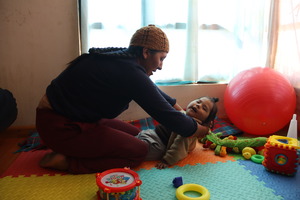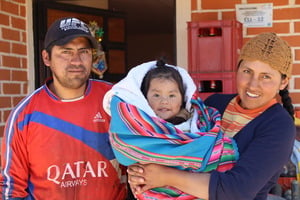Facilitating access to healthcare for Altiplano communities in Bolivia
Rosalía's son was born with cerebral palsy following a difficult birth. Their journey through the healthcare system has been fraught with difficulties but the boy is receiving the support he needs.

Rosalía Alarcón and her son Jair, in Calamarca, Bolivia. | © M. Campos / HI
Rosalía Alarcón, 22, lives in Calamarca, a small village in the Bolivian Altiplano, a high plateau in the Andes mountains at an altitude of almost 4,000 metres. Her family earns a living from the sale of fodder to the local llama and goat farms. Rosalía has two children. Her daughter Ludimax is 5 years old and her son Jair is almost two. Jair was born with cerebral palsy, a disability that could have been prevented if Rosalía had received better care during pregnancy and childbirth.
Problems receiving the appropriate care
 During her pregnancy with Jair, Rosalía had no complications until the third month, when she was informed of the presence of a haematoma. But the doctors reassured her, telling her that everything was normal and that the baby was fine. One night, towards the end of her pregnancy, Rosalía woke up in great pain. She wanted to go to the nearest health centre, more than an hour's drive away, but in Calamarca, buses only run for a few hours a day, making travelling very difficult. Rosalía's family owns a motorbike, but as she was about to give birth, this was of no use to her. Rosalía had to ask her neighbour to take her.
During her pregnancy with Jair, Rosalía had no complications until the third month, when she was informed of the presence of a haematoma. But the doctors reassured her, telling her that everything was normal and that the baby was fine. One night, towards the end of her pregnancy, Rosalía woke up in great pain. She wanted to go to the nearest health centre, more than an hour's drive away, but in Calamarca, buses only run for a few hours a day, making travelling very difficult. Rosalía's family owns a motorbike, but as she was about to give birth, this was of no use to her. Rosalía had to ask her neighbour to take her.
The doctors examined her and, concluding that the baby was not ready to be born, sent her home. All the next day, Rosalía was paralysed with pain.
”I went back to the health centre and was told that my baby was ready to be born. Then I waited all day... In the evening, I was told to go to another hospital, because they couldn't take me. They never gave me anything for the pain or sent me for any tests. I was just examined and that was it. I wasn’t given much information either,” Rosalía explains.
Distant health services
The following day, two days after her pains had started Rosalía finally gave birth.
“When Jair was born, he didn't cry. I was scared because everything was so different from my first birth. When they handed him to me, I could hear his breathing was laboured. I could also see that his skin was very yellow, but the nurses told me everything was fine and that I just needed to put him in the sun.”
Rosalía noticed straight away that her son was very calm - too calm. For months, the doctors assured her that there was nothing wrong. But when, after a year, Jair showed no signs of wanting to walk or crawl, Rosalía decided to go to another hospital where the little boy was finally diagnosed with cerebral palsy.
Rosalía and Jair started to attend therapy sessions, but getting to the health centre was a real obstacle course. The sessions were in La Paz, at least 2 hours away depending on the traffic.
“I would leave home at 10am by bus and then wait for my turn at the health centre. Sometimes I didn't leave until 3pm and if I was too late for the bus, I would have to walk home carrying Jair on my back.”
The benefits of local care
 One day, Rosalía explained to the doctor that she had to come a long way for the sessions. The doctor referred her to the Calamarca rehabilitation centre, a centre that HI supports by providing training and equipment.
One day, Rosalía explained to the doctor that she had to come a long way for the sessions. The doctor referred her to the Calamarca rehabilitation centre, a centre that HI supports by providing training and equipment.
“It was the best thing that could have happened to us. Now it only takes us 15 minutes by motorbike to get to the sessions and I can spend more time at home looking after my daughter too. Some days, it’s the carers who come to us for the sessions.”
Rosalía and Jair go to the rehabilitation centre twice a week where the physical therapists give Jair exercises to develop his motor skills. The teams have also taught Rosalía a few exercises so she can continue the sessions at home.
“Since we've been attending therapy at the rehabilitation centre, the changes in Jair have been remarkable. Now he's started to walk on all fours, he can roll over on his own and he's babbling. I take him to see the neuro-paediatrician every month for follow-up, and every time I go, he sees progress in Jair’s cerebral and motor skills.”
The “Improving the rehabilitation and health of children and adolescents in Bolivia” project is funded by DGD. It has enabled the training of some 500 health professionals and the provision of equipment for mobile teams in 13 health centres, to promote better patient care. 734 people received equipment to reinforce rehabilitation at home, and 314 parents benefited from psychosocial support.





